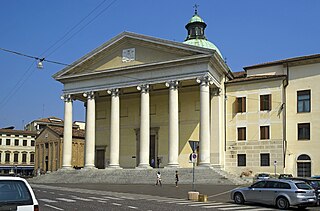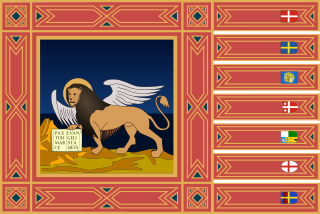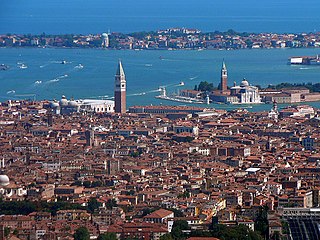
Verona is a city on the River Adige in Veneto, Italy, with 258,031 inhabitants. It is one of the seven provincial capitals of the region, and is the largest city municipality in the region and in northeastern Italy. The metropolitan area of Verona covers an area of 1,426 km2 (550.58 sq mi) and has a population of 714,310 inhabitants. It is one of the main tourist destinations in Northern Italy because of its artistic heritage and several annual fairs and shows as well as the opera season in the Arena, an ancient Roman amphitheater.

Ezzelino III da Romano was an Italian feudal lord, a member of the Ezzelini family, in the March of Treviso. He was a close ally of the emperor Frederick II, and ruled Verona, Vicenza and Padua for almost two decades. He became infamous as a cruel tyrant, and was, in fact, the most "notorious" of the "early tyrants".

Treviso is a city and comune (municipality) in the Veneto region of northern Italy. It is the capital of the province of Treviso and the municipality has 85,188 inhabitants. Some 3,000 live within the Venetian walls or in the historical and monumental center; some 80,000 live in the urban center while the city hinterland has a population of approximately 170,000.

The province of Treviso is a province in the Veneto region of Italy. Its capital is the city of Treviso. The province is surrounded by Belluno in the north, Vicenza in the west, Padua in southwest, Venice in the south-east and Friuli-Venezia Giulia in the east. The current President of Treviso is Stefano Marcon, elected in September 2016. He is also the current mayor of Castelfranco Veneto.

Niccolò di Pitigliano (1442–1510) was an Italian condottiero best known as the Captain-General of the Venetians during the Most Serene Republic's war against the League of Cambrai. He was a member of the powerful feudal family of the Orsini, belonging to its Pitigliano line.

Cangrandedella Scala was an Italian nobleman, belonging to the della Scala family that ruled Verona from 1308 until 1387. He was indeed one of the most important characters at the time of signorie during the period where italy divided in comuni. Now perhaps best known as the leading patron of the poet Dante Alighieri and featuring prominently in Giovanni Boccaccio's almost contemporary Decameron, Cangrande was in his own day chiefly acclaimed as a successful warrior and autocrat. Between becoming sole ruler of Verona in 1311 and his death in 1329 he took control of several neighbouring cities, notably Vicenza, Padua and Treviso, and came to be regarded as the leader of the Ghibelline faction in northern Italy.

Valdobbiadene is a town and comune (municipality) in the province of Treviso, Veneto, Italy. Valdobbiadene is a wine growing area: located below the Alpine-Dolomite areas of Veneto, the climate allows the cultivation of the Glera variety of grape.

San Donà di Piave is a city and comune in the Metropolitan City of Venice, Veneto, northern Italy. It is one of the historical main towns of the Eastern Veneto territory, although it was totally reconstructed in the early 1920s after being heavily damaged during the World War I.

Mussolente is a town in the province of Vicenza, Veneto, northern Italy. It is north of SS248 state road.
San Zenone degli Ezzelini is a comune (municipality) in the Province of Treviso in the Italian region Veneto, located about 50 kilometres (31 mi) northwest of Venice and about 35 kilometres (22 mi) northwest of Treviso.
Cunizza da Romano was an Italian noblewoman and a member of the da Romano dynasty, one of the most prominent families in northeastern Italy, Cunizza's marriages and liaisons, most notably with troubadour Sordello da Goito, are widely documented. Cunizza also appears as a character in a number of works of literature, such as Dante Alighieri's Divine Comedy.

The March of Verona and Aquileia was a vast march of the Holy Roman Empire in the northeastern Italian region during the Middle Ages, centered on the cities of Verona and Aquileia. Seized by King Otto I of Germany in 952, it was held by the Dukes of Bavaria; from 976 in personal union with the Duchy of Carinthia. The margravial regime ended with the advent of the Lombard League in 1167.

This page gathers the results of elections in Veneto.
The Pelagians were a lay confraternity founded in the church of Santa Pelagia in Milan by the seventeenth century Giacomo Filippo di Santa Pelagia, an Italian lay mystic. Although initially approved of by Roman Catholic authorities, the group was later condemned for alleged heretical practices associated with Quietism.

Padova railway station, or Padua railway station, sometimes referred to as Padova Centrale, is the main station serving the city and comune of Padua, in the Veneto region, northeastern Italy.

The Metropolitan City of Venice is a metropolitan city in the Veneto region of Italy, one of ten metropolitan cities in Italy. Its capital is the city of Venice. It replaced the province of Venice in 2015 and includes the city of Venice and 43 comuni. It was first created by the reform of local authorities and then established by Law 56/2014.

Cassa di Risparmio della Marca Trivigiana, also known as Cassamarca in short, was an Italian savings bank headquartered in Treviso, Veneto. The history of the bank goes back to 1496 when the charitable institution Monte di Pietà di Treviso was founded. The savings bank was established by the Monte in 1907, following a first bank spinoff in 1822 that ended up being absorbed in 1872 by the Cassa di Risparmio delle Provincie Lombarde.
Giordano Forzatè, anglicized as Jordan Forzatè, was a Paduan Benedictine monk and religious leader. For his noble background, peacemaking efforts, and monastic reforms, the Chronicle of the Trevisan March calls him the pater Padue, "father of Padua".
The War of the Castle of Love was a conflict in 1215–1216 between Padua and Treviso on one side and Venice on the other. It began with an exchange of insults at a festival, escalated to raiding and finally to open warfare. The decisive engagement was fought near the mouth of the Adige on 22 October 1215 and a peace treaty was signed on 9 April 1216.
Pieve del Grappa is a comune in the province of Treviso, Veneto region of Italy. It was formed on 30 January 2019 with the merger of the comunes of Crespano del Grappa and Paderno del Grappa.













